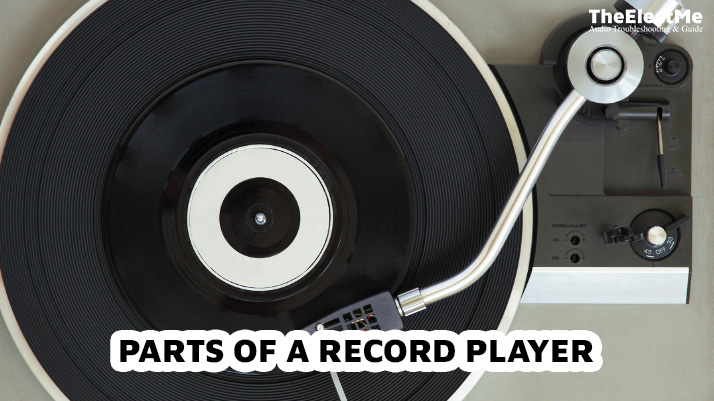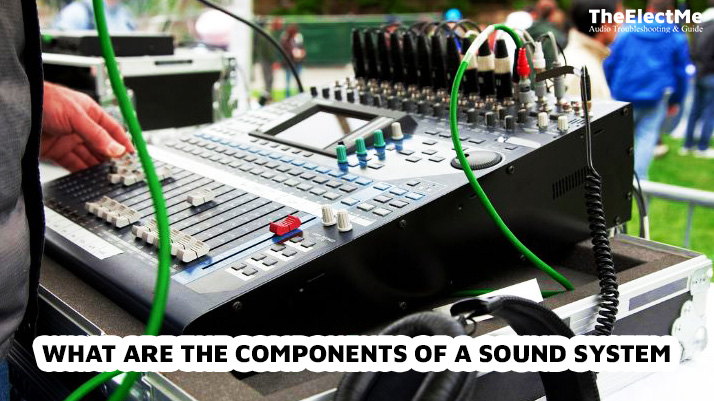The plinth, platter and tonearm are critical parts of a record player. Digital music dominates our listening, but playing music on a record player has a nostalgic charm and appeal.
But have you ever wondered about the inner workings of this iconic music device? To know more about record players, read this article as we dive into the different parts of a record player and how they work.

What are the Parts of a Record Player, And How Do They Work?
A record player may seem like a simple device, but it is a complex piece of machinery. Let’s look at the different parts that make up this musical marvel.
1. Plinth
A plinth is the base or foundation of a record player. It provides stability and support for the other parts of the record player. The location of the plinth can vary depending on the design and type of record player. It is usually placed at the bottom of the device.
As a result, the sound produced by the record player is more precise and more defined.
2. Platter
A platter is the circular surface on which the vinyl record sits. It is responsible for spinning the record constantly, allowing the stylus to track the grooves and produce sound.
The platter is usually powered by a motor located underneath it. The platter can be manually rotated in some record players using a belt drive system. This manual rotation helps to reduce vibrations and improve sound quality.
3. Tonearm
The tonearm is one of the most essential parts of a record player. It holds the stylus or needle that runs along the vinyl record’s grooves. The tonearm is responsible for transmitting the vibrations from the stylus to the cartridge.
Otherwise, it can result in poor sound quality or even damage the record.
4. Cartridge
The cartridge is the device that holds the stylus and converts mechanical vibrations into electrical signals. It is a small but crucial part of the record player. The type and quality of the cartridge can significantly affect the sound produced by the record player.

There are two types of cartridges – moving magnet (MM) and moving coil (MC).
a) MM cartridges
This cartridge type has a fixed magnet and a moving coil that attaches to the stylus. When the stylus moves, it creates an electrical signal. MM cartridges are known for their high output and compatibility with various record players.
b) MC cartridges
This cartridge type has a fixed coil and a moving magnet attached to the stylus. The movement of the interest creates an electrical signal. MC cartridges are known for their superior sound quality but require a unique phono preamp to function correctly.
5. The Motor and Belt Drive
The motor is responsible for spinning the platter at a constant speed. In direct-drive record players, the motor is directly attached to the platter. In contrast, belt drive systems connect the motor and platter with an elastic belt.
Belt drive systems help to isolate vibrations from the motor, resulting in better sound quality. They also allow manual speed adjustment, which is crucial for DJs and audiophiles.
6. Dust Cover
A dust cover is a protective lid covering the record player when not used. It helps to keep dust and other particles from settling on the record player’s delicate parts.
Dust can cause damage to the stylus and affect sound quality. Therefore, a dust cover is essential for a record player to ensure its longevity and optimal performance.

7. Anti-Skating Mechanism
The anti-skating mechanism is a small device that helps the tonearm to remain in the centre of the record. It prevents the stylus from being pulled towards either side of the groove, which can cause distortion or damage to the record.
Without this mechanism, records can have tracking issues. The anti-skating mechanism can be adjusted using a dial or weight system to suit the weight of the tonearm and cartridge. So, carefully setting this mechanism for optimal sound quality is essential.
8. Accessories
Aside from the main components listed above, various accessories present record players. Some standard accessories include:

a) Record cleaning kit
This kit includes a brush and solution for removing dust and dirt from records, resulting in better sound quality.
b) Counterweight
This accessory properly balances the tonearm, ensuring accurate tracking and preventing damage to records.
c) Needle or Stylus
This part of the cartridge makes contact with the record’s grooves. Upgrading to a high-quality needle or stylus can significantly improve sound quality.
d) Speed adjustment tools
These tools allow for precise speed adjustments. It is beneficial for DJs who must match the records’ speed when mixing.

So, these are some of the essential accessories that can enhance the listening experience on a record player. Let’s move to the next part: why gaining knowledge on record players is vital.
Why It Is Important To Gain Knowledge Of Record Players?
Record players have been around since the late 19th century. Over the years, they have evolved and undergone many changes. With the rise of digital music, record players are now more popular than they once were.
Knowing record players allows you to understand their different components. With this knowledge, you can make informed decisions when purchasing a record player or upgrading its parts. It also helps care for and maintain your record player appropriately, ensuring longevity.
Final Thought – Parts Of A Record Players
To summarise, the parts of a record player include the stylus, tonearm, cartridge, motor, platter, dust cover, and anti-skating mechanism. Each component plays a vital role in producing high-quality sound from records.
Additionally, proper knowledge about record players can enhance your listening experience. Your money and time investment in a record player can be maximized by understanding its various parts and their functions.
So, keep exploring and learning about this classic piece of music technology.



